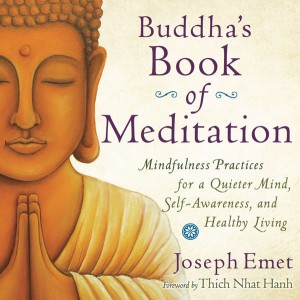 The following songs and guided meditations are designed to accompany Buddha’s Book of Meditation (Tarcher/Penguin). Each chapter in that book describes and clarifies the meaning of one of these exercises.
The following songs and guided meditations are designed to accompany Buddha’s Book of Meditation (Tarcher/Penguin). Each chapter in that book describes and clarifies the meaning of one of these exercises.
Please click on each item to play it, or right-click and choose Save to save it to your computer.
Guided meditations:
Practice songs:
- It’s the Light That I Long for
- A Smile With Every Breath
- You’re a Leaf on the Tree of Life
- Heal Yourself With the Mind of Love
- There’s Honey in Each Moment
- Just Breathe
- Buddha’s Garden
- Coming Back to Your Home
- The Light in Each One
- Island of Peace
- Lay Down Your Burden
- Be Yourself
Buddha’s Book of Meditation offers mindfulness as a complement to our physical evolution, and as an effective counterweight to our evolutionary urges. With mindfulness we recognize all our urges, and we learn to breathe and smile at them. Mindfulness is a support for loving relationships, for happiness, and for personal and world peace—it is an essential practice for all of us. Otherwise, the negativity bias of our brain prevents us from fully appreciating all the beauty that is around us. This book offers exercises, mantras, and guided meditations for driving its message home.
Sample passages
From the NOTES TO THE READER:
Self-regulation, better relationships, and developing a compassionate heart are significant benefits of meditation; in this book, they are given the importance that they deserve.
We recognize now that the role of the brain in guiding our life has its downside as well as its many benefits. I use the word brainfulness to describe an attitude of unexamined bondage to the biases and priorities of this organ, and suggest that mindfulness is an effective counterweight to it.
Practice material is integrated into every chapter⎯and to make practice sessions more enjoyable, many of the exercises are songs that you can download and use as “mindfulness mantras” to inspire and guide your practice. The message of this book is empowering; whether you would like to be more positive, more peaceful, less anxious, or angry less often, you can change in ways that you desire.
The brain is plaster, you are the sculptor, and mindfulness meditation is the tool.
It is my fervent wish that this book will be useful to meditation students and teachers and to those in the helping professions who want to use meditation with their clients.
EMBODIED WISDOM:
Do you remember the time when you were learning to drive?
The rules of traffic are pretty simple, but an intellectual knowledge of driving a car is different from the feeling you get when you slip behind the wheel. Now, your body needs to drive the car as well as your brain; your feet, your hands, your eyes and ears need to be coordinated with your thoughts. When you think left turn, your body must execute the maneuver smoothly.
Embodying peace is also quite an apprenticeship.
You can read about peace in a book by Thich Nhat Hanh in relatively short time.
But consistently embodying peace as you walk, eat, and do the dishes every day is another matter. And speaking peacefully, under provocation in an argument, under stress in front of a group, or when you feel anger takes a whole lot more than an intellectual understanding of peace.
Relax.
People spend eight weeks in a stress reduction course to teach that one word to their bodies. And some come back for a second session.
